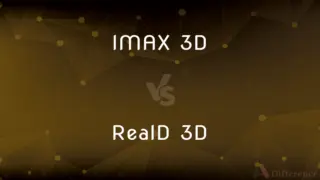Magnetic Force vs. Electric Force — What's the Difference?
By Maham Liaqat & Fiza Rafique — Published on March 6, 2024
Magnetic force arises from moving charges and magnetic materials, affecting magnetic objects, while electric force is caused by charge interactions, influencing charged particles.

Difference Between Magnetic Force and Electric Force
Table of Contents
ADVERTISEMENT
Key Differences
Magnetic force is a consequence of moving electric charges or inherent in magnetic materials, acting at right angles to the motion of charged particles. It influences objects with magnetic properties, causing attraction or repulsion based on magnetic field orientation.
Electric force originates from the interaction between static or moving electric charges. Governed by Coulomb's law, it acts along the line connecting two charges, directly influencing charged particles with attractive or repulsive forces depending on charge polarity.
The relationship between magnetic and electric forces is foundational to electromagnetism. Changing electric fields can generate magnetic fields and vice versa, a principle exploited in technologies like generators and motors.
Magnetic fields require moving charges or magnetic materials to exist, while electric fields can exist around static charges. This distinction underpins the separate but interrelated nature of magnetic and electric phenomena.
While magnetic force acts on objects with magnetic properties, including moving charged particles, electric force applies to all charged particles, regardless of their motion. This difference is crucial in understanding the behavior of materials and particles in various fields.
ADVERTISEMENT
Comparison Chart
Source
Moving charges, magnetic materials
Static or moving charges
Direction
Perpendicular to the motion of charged particles
Along the line connecting two charges
Influence
Magnetic materials, moving charged particles
All charged particles
Field Generation
Requires motion or magnetic materials
Can be generated by static charges
Governing Law
Lorentz force law
Coulomb's law
Compare with Definitions
Magnetic Force
Generated by moving charges or inherent in materials.
Electromagnets create a magnetic force when electric current flows through a coil.
Electric Force
Governed by Coulomb's law.
The force between two charges decreases with the square of the distance between them.
Magnetic Force
Influences materials with magnetic properties.
Iron filings align along magnetic field lines due to magnetic force.
Electric Force
Influences all charged particles.
Electric fields guide ions in a mass spectrometer.
Magnetic Force
Magnetic force is the attraction or repulsion between magnetic poles.
A compass needle's direction is influenced by the Earth's magnetic force.
Electric Force
It acts along the line between charges.
Electrons are held in orbit around nuclei by electric force.
Magnetic Force
It acts perpendicular to the motion of moving charges.
Particles in a cyclotron experience a magnetic force that curves their path.
Electric Force
Can exist around static charges.
A balloon rubbed on hair will stick to a wall due to static electric force.
Magnetic Force
Can induce an electric current.
Moving a magnet through a coil generates electricity due to magnetic force.
Electric Force
Electric force is the interaction between charged particles.
Oppositely charged particles attract due to electric force.
Common Curiosities
How do magnetic and electric forces differ in source?
Magnetic force originates from moving charges or magnetic materials, while electric force comes from static or moving charges.
Can electric force act on uncharged objects?
No, electric force acts on charged particles; however, induced charges can cause interactions with uncharged objects.
What is magnetic force?
Magnetic force is the force exerted by magnets or moving electric charges, affecting magnetic materials and charged particles.
Are magnetic fields always generated by moving charges?
Yes, magnetic fields are generated by moving charges or by the inherent magnetic properties of materials.
Can magnetic force influence all materials?
Magnetic force primarily affects magnetic materials and moving charged particles, not all materials.
What is electric force?
Electric force is the attraction or repulsion between charged particles, governed by their charge and distance.
What is Coulomb's law?
Coulomb's law describes the electric force between two charged objects, depending on their charges and distance apart.
How do magnetic and electric forces affect technology?
They underpin the operation of many technologies, from electric motors and generators to communication systems.
How does the direction of magnetic and electric forces differ?
Magnetic force acts perpendicular to the motion of charged particles, whereas electric force acts along the line between charges.
What role do magnetic and electric forces play in electromagnetism?
They are fundamental to electromagnetism, with changing magnetic fields generating electric fields and vice versa.
Is electric force stronger than magnetic force?
The strength depends on the context; electric force can be stronger in interactions between static charges, but both forces are fundamental and can be very strong in different situations.
How can magnetic force induce an electric current?
Moving a magnetic field relative to a conductor or vice versa can induce an electric current due to electromagnetic induction.
Why do charged particles move in a circular path in a magnetic field?
The magnetic force acts perpendicular to their velocity, causing them to move in circular or spiral paths.
What is Lorentz force law?
Lorentz force law describes the combined effect of electric and magnetic forces on a charged particle.
What happens when electric and magnetic forces act together?
When acting together, they can exert a combined force on charged particles, influencing their motion and trajectory in complex ways.
Share Your Discovery

Previous Comparison
Alignment vs. Balancing
Next Comparison
IMAX 3D vs. RealD 3DAuthor Spotlight
Written by
Maham LiaqatCo-written by
Fiza RafiqueFiza Rafique is a skilled content writer at AskDifference.com, where she meticulously refines and enhances written pieces. Drawing from her vast editorial expertise, Fiza ensures clarity, accuracy, and precision in every article. Passionate about language, she continually seeks to elevate the quality of content for readers worldwide.













































